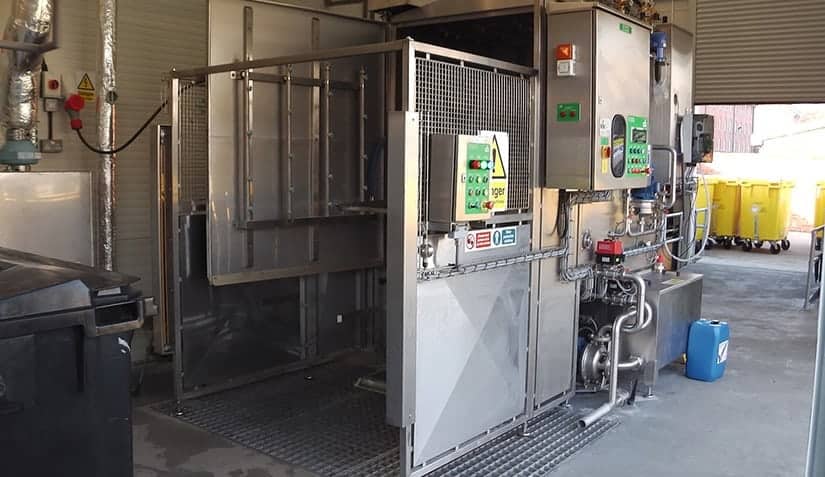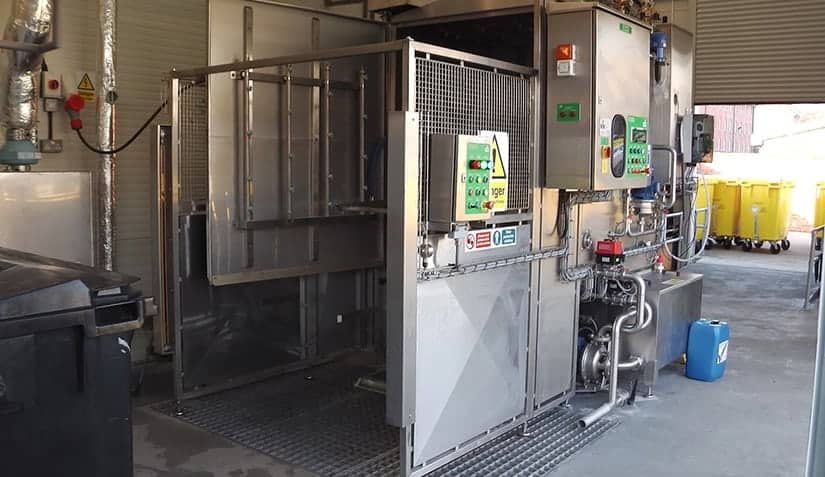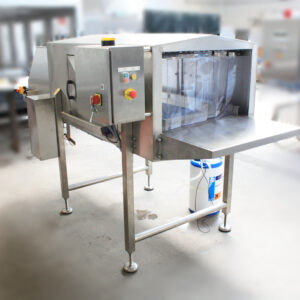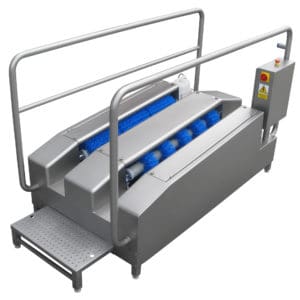For Industrial Washing Machines Limited (IWM) supplying bin washing machines is nothing new. The company is one of the UK’s leading manufacturers of these products. Therefore, it was normal to be asked by Eurotec Environmental to provide a bin cleaning machine for a hospital application. However, the capacity of the electrical supply was very limited. So, the design team at IWM had to do some careful thinking. Devise a way of reducing the electrical loading of the machine, without compromising its performance.

Bin Washing Machines
Eurotec Environmental specialises in delivering sustainable eco-friendly waste management solutions. The specification of the bin washer machine required was very straightforward. It needed to wash either two 360 litre bins simultaneously, or a single 720 litre bin. Furthermore, the throughput needed was eight cycles per hour. Each cycle comprising two of the smaller bins or one of the larger ones.
Highest Standards Of Cleanliness And Hygiene
Because this was a hospital application, the highest standards of cleanliness and hygiene had to be observed. So, the bin washer machine had to provide a hot wash, followed by either a hot rinse, or a cold rinse. In addition, including a chemical sanitising agent, as selected by the operator. The heaters and pumps had to be electrically operated, as no other source of heat or power was available.
IWM Bin Washers
The electrical supply available in the area, where the machine was to be installed, had a maximum capacity of just 40 A. This is well below the peak current requirement of the standard IWM bin washers. Therefore, this presented a challenge.
To address this challenge, IWM’s design engineers carefully examined the machine’s operating cycle. Therefore, they found that it would be possible to reduce the peak power requirements in two ways.
The first was to wash the inside and outside of the bins separately. Rather than supplying water to the jets, washing the inside and the outside of the bins simultaneously. Therefore, a smaller pump would be used.
The second measure used to reduce the peak current requirement of the machine, was to interlock the operation of the water heaters with the pump. That way if the heaters were operating, the pumps would not run, and vice versa. In addition, it would no effect on the overall efficiency of the machine. This is because with the low throughput needed, it was perfectly practical to turn the heaters on for short periods between washes. Therefore, maintaining the wash water at the required temperature.
Energy Efficient
Aside from these special adaptations, the design of the bin washer followed IWM’s standard practice. This includes the use of hygienic corrosion resistant stainless steel for all major structural components, and a wash system based on continuous high-pressure jetting with a water-detergent mixture that is re-circulated from a heated tank to minimise the usage of both water and detergent. Recirculation also reduces heating requirements, making the machine more energy efficient.
Extensive Trials Were Carried Out
On completion of the new machine with its special customisation, IWM carried out extensive trials. This made sure that it would be suitable for operation from the limited-capacity electrical supply in the hospital. These trials confirmed that the maximum load under worst-case conditions was 36 A, well below the specified limit of 40 A. The trials also demonstrated that the modifications had in no way reduced the effectiveness of the machine. In addition, after washing, the bins consistently met or exceeded the hospital’s strict specifications for cleanliness.
“IWM did an excellent job on this project,” said Terry Hewitt of Eurotec Environmental. “Although the limited electrical supply could have been a big problem, the IWM team rose to the challenge and found a practical and cost-effective way of dealing with it. The results are excellent – we’re delighted, and so is the end customer.”
If you enjoyed reading this blog, why not take a look at: Boot Washers UK: Why Are They Important For Food Production Facilities?





